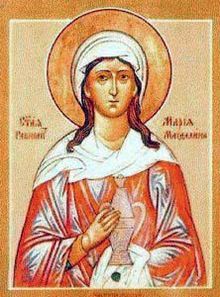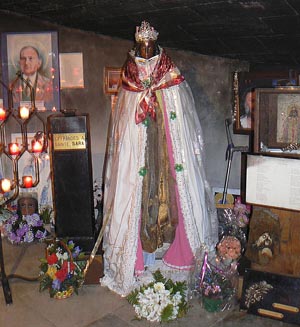By Melissa MacDonald
The breathtakingly beautiful South of France, with its balmy air and pellucid ocean coast, has more to offer the traveler than just a pleasant climate. It was here, according to legend, that Mary Magdalene came in her later years to preach, heal, convert, and eventually ascend to heaven. Her final years she spent in a solitary mountain existence, imbued with deep spirituality and gaining great wisdom. The profound, feminine spiritual power of sites associated with her in this region can still be felt as deeply by modern travelers as it was by the pilgrims of medieval times.
The legacy of Mary Magdalene

Mary Magdalene is an intriguing character, considered by many to be deeply sacred. Maligned for centuries as a prostitute by the Vatican – who were perhaps a little wary of spiritual authority vested in a female – she is slowly being reinstated to her former position as a valued disciple of Jesus and a keystone of Christianity. According to the Gospels, Mary Magdalene was the first person to see Jesus after his resurrection, making her a very important Christian figure indeed. Gnostic gospels and other non-canonical early Christian writings paint a vivid picture of Mary as a prominent leader of the early church, blessed with visions, privileged with divine insight, and a bearer of deep spiritual wisdom. Mary Magdalene is often thought to be the Mary at Bethany who anointed and washed the feet of Jesus using spikenard oil and her own hair, and who helped to prepare his body for burial with sweet-smelling embalming oils. For these reasons, the use of oils is greatly associated with the ministry of Mary Magdalene. Oils are still used in healing today, and authorities on the subject, such as Licensed Prescriptions, claim they can ‘benefit the health and wellbeing of the ‘whole person’, as well as being an effective tool for stress relief. Mary Magdalene is credited in legend with bringing knowledge of essential healing oils to France and thus to Europe, giving the people much needed knowledge of how to heal their souls as well as their bodies. A trip to her holy sites in the South of France is equally healing – a soothing balm for spirits that may be troubled or grieving.
Saintes-Marie-de-la-Mer

Christianity has been accused of androcentrism, and considered by some to be spiritually deficient due to its lack of an adequate divine feminine principle. However, sites associated with Mary Magdalene in Southern France have feminine spiritual energy in abundance. Mary Magdalene is said to have arrived in Southern France around 42 CE with a few holy companions. They had drifted from the Holy Land in a boat without oars – possibly cast out as a form of exile which was generally expected to become an execution. However, their boat was blown over the Mediterranean, to land on the shores of the town now known as Saintes-Marie-de-la-Mer (‘Saint Marys of the Sea’). Now capital of the Carmargue region, this place has been a place of great spiritual energy and pilgrimage since pre-Christian times. Its associations with Mary and her companions built it into a true spiritual heartland. A weathered wooden cross marks the spot where there boat is said to have blown to shore – powerful in its simplicity. Holy wells, said to have leaped joyfully from the land at the instigation of the saintly party, can be found in the beautiful church, and the power of the place is clearly felt by even the most spiritually obtuse. One of the holy company – Saint Sarah – said to have devoted her life to serving Mary, is venerated as patron saint of the gypsies, and every year in May gypsies converge in joyful pilgrimage on the town, to replenish their souls and feel the simple, strong healing energies of the area. A visit to this place is tremendously regenerative, permeating the spiritually aware with a great sense of hope, and imbued with a rich atmosphere which works actively to heal the emotionally damaged.
Sainte-Baume – shamanic mountain grotto
Mary Magdalene’s legend continues. The tale goes that she left Saintes-Marie-de-la-Mer and travelled up into Sainte-Baume. This is a stunning range of mountains in the center of Provence, situated almost exactly between the Alps and the sea. There she chose to live in a natural grotto, a cave in the heart of the mountain itself. Her life was one of contemplation, of meditation, and of ultimate spiritual enlightenment. This grotto was her Bodhi Tree – here, she learned to lose her human wants and to be sustained by the spirit. Her body, according to legend, was nourished for thirty years by Holy Eucharist brought to her by angels, until she dispensed with the needs of the body entirely, and ascended directly to heaven. Her mountain is a sacred, protected location, and a site of spiritual pilgrimage for centuries. Paths once travelled by popes and kings on pilgrimage wind up to the grotto, through cool forests and along beautiful mountain paths. The forests of Sainte-Baume are sacred, and have been protected for thousands of years. They maintain an almost eldritch air of enchantment. Mary’s cave grotto, probably a site of worship since pre-Christian times due to its undeniable spiritually healing atmosphere, is replete with almost tangible sacred, feminine energies. Entering her cave grotto is like entering the womb of the mountain itself. The cave retains much of its natural, simple rocky beauty. Shrines, statuary, art, and Mary’s beautiful reliquary enhance rather than overbear the natural qualities of the cave, rendering a visit to it an almost shamanic experience. Red, white, and black color schemes in the tiles bring to mind the colors of prehistoric cave art. Thousands of years ago, the ancestors worshipped a feminine, maternal energy in caves just such as this, through similar colors and art. This reverence for the feminine is much lacking in modern times, leaving a damaging gap in many psyches. Mary’s grotto at Sainte-Baume can help visitors to reconnect with the sacred feminine, and free the female aspect of their spirit from mental oppression. Indeed, the cave could almost be seen as a transformative tomb, or regenerative womb, through which pilgrims pass to lay to rest their torments, emerging on the other side with spirits reborn.
Reconnection with the feminine, transformation in spirit
Mary Magdalene’s part in early Christianity is shrouded in controversy brought about by anti-feminine sentiment and conspiracy theories. However, the heart of the part she has to play in early Christian writings is one of exquisite love, and transformative grief. Mary tenderly anoints Christ’s feet with oils, witnesses his sufferings on the Cross when others prefer to leave, embalms and prepares his body for burial, and visits his grave to express her sorrows. It is during this latter activity that she is rewarded for her refusal to shy away from her suffering – she is the blessed apostle who is first granted a personal audience with the risen Jesus, thus learning firsthand about spiritual resurrection. Visiting Mary’s sacred sites help people to reconnect with the inner strength of the feminine spirit, which does not shy away from emotional hardship but instead admits it, faces it, works through it, and in so doing ultimately regenerates the damaged psyche, transforming it into something spiritually stronger and more profound.
Kathleen McGowan, the best-selling author of the Magdalene Line series of novels, The Expected One, The Book of Love and The Poet Prince, hosts Sacred France tours that visit sites associated with Mary Magdalene.
UPDATE: Kathleen McGowan is holding a “Magdalene Movement” women’s retreat in Santa Fe, New Mexico Oct. 24 – 27, 2019 . She will also be leading a Holy Land tour in March, 2020 and a Sacred Italy tour in June, 2020.
Photo of Saint Sarah at shrine in Saintes-Maries-de-la-Mer by Acoma